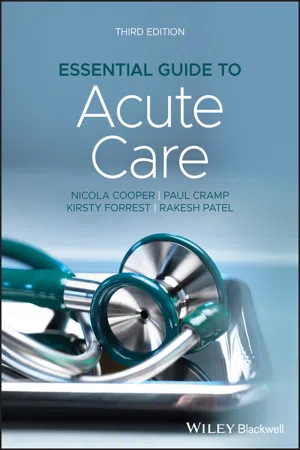
- English
- ePUB (mobile friendly)
- Available on iOS & Android
Essential Guide to Acute Care
About this book
What you really need to know, but no-one told you.
The best-selling Essential Guide to Acute Care contains everything you need to know about acute care that you can't find in a standard textbook. The third edition has been extensively revised and updated, presenting new oxygen guidelines, updated evidence and practice around sepsis, fluid balance and volume resuscitation, acute kidney injury, perioperative care, and much more.
The third edition retains the accessible style and comprehensive coverage that has made Essential Guide to Acute Care essential reading for those who look after acutely ill adults. Throughout the book, 'mini-tutorials' expand on the latest thinking or controversies, and there are practical case histories to reinforce learning at the end of each chapter. The chapters are designed to be read by individuals or used for teaching material in tutorials.
This new edition of Essential Guide to Acute Care:
- Provides up-to-date and practical guidance on the principles of acute care, written by experienced teachers and clinicians
- Offers a unique approach to the subject that focuses on understanding rather than lists and 'recipes'
- Explains the altered physiology that accompanies acute illness in adults Includes learning objectives, self-assessment questions, and illustrative examples related to clinical practice
Essential Guide to Acute Care is an indispensable volume for medical students and newly graduated doctors; doctors training in medicine, surgery, anaesthesia and emergency medicine; advanced clinical practitioners; nurses and allied health professionals working in acute and critical care; and teachers.
Frequently asked questions
- Essential is ideal for learners and professionals who enjoy exploring a wide range of subjects. Access the Essential Library with 800,000+ trusted titles and best-sellers across business, personal growth, and the humanities. Includes unlimited reading time and Standard Read Aloud voice.
- Complete: Perfect for advanced learners and researchers needing full, unrestricted access. Unlock 1.4M+ books across hundreds of subjects, including academic and specialized titles. The Complete Plan also includes advanced features like Premium Read Aloud and Research Assistant.
Please note we cannot support devices running on iOS 13 and Android 7 or earlier. Learn more about using the app.
Information
CHAPTER 1
Patients at Risk
- Define resuscitation
- Recognise the importance of the generic altered physiology that accompanies acute illness
- Know that early recognition and management improves outcomes
- Know how to assess and manage an acutely ill patient using the ABCDE system
- Understand the benefits and limitations of intensive care
- Know how to communicate effectively with colleagues about acutely ill patients
- Have a context for the chapters that follow
What is Resuscitation?
Deficiencies in the recognition of ill patients have been identified for many years and the care of the acutely ill hospitalised patient presents ongoing problems for healthcare services. Deficiencies are often related to poor management of simple aspects of acute care – those involving ...
Table of contents
- Cover
- Table of Contents
- Title Page
- Copyright Page
- Reviews of the Second Edition
- Introduction
- Acknowledgements
- Foreword to the Second Edition
- Units Used in This Book
- List of Abbreviations
- CHAPTER 1: Patients at Risk
- CHAPTER 2: Oxygen Therapy
- CHAPTER 3: Acid–Base Balance
- CHAPTER 4: Respiratory Failure
- CHAPTER 5: Fluid Balance and Volume Resuscitation
- CHAPTER 6: Sepsis
- CHAPTER 7: Acute Kidney Injury
- CHAPTER 8: Brain Injury
- CHAPTER 9: Optimising Patients Before Surgery
- CHAPTER 10: Pain Control and Sedation
- Index
- End User License Agreement